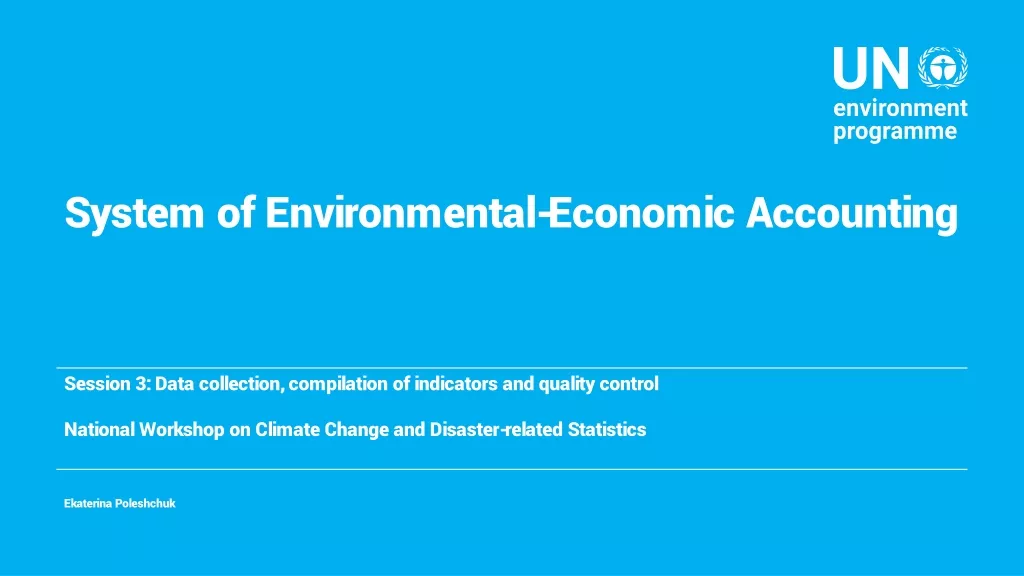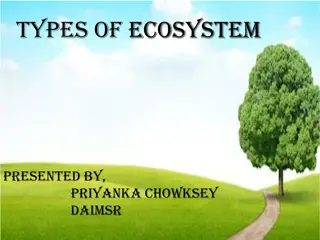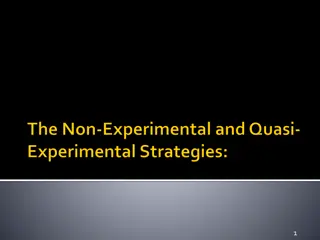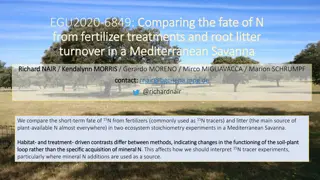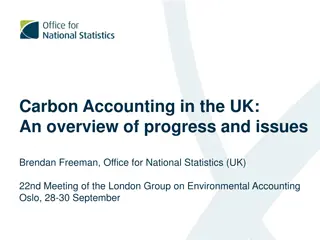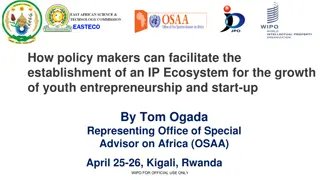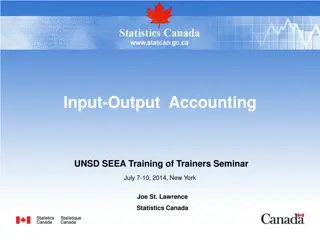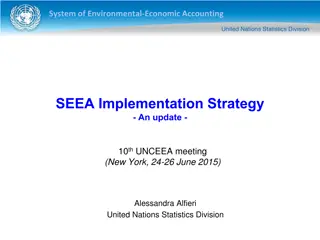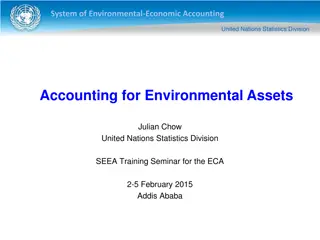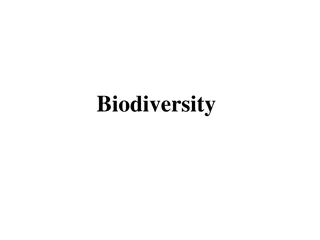System of Environmental-Economic Accounting and Experimental Ecosystem Accounting Overview
The System of Environmental-Economic Accounting (SEEA) and Experimental Ecosystem Accounting aim to integrate biophysical data, monitor ecosystem changes, and link them to economic activities. They provide a framework for accounting for ecosystem assets and services, playing a crucial role in the post-2015 development agenda and Sustainable Development Goals.
Download Presentation

Please find below an Image/Link to download the presentation.
The content on the website is provided AS IS for your information and personal use only. It may not be sold, licensed, or shared on other websites without obtaining consent from the author.If you encounter any issues during the download, it is possible that the publisher has removed the file from their server.
You are allowed to download the files provided on this website for personal or commercial use, subject to the condition that they are used lawfully. All files are the property of their respective owners.
The content on the website is provided AS IS for your information and personal use only. It may not be sold, licensed, or shared on other websites without obtaining consent from the author.
E N D
Presentation Transcript
System of Environmental-Economic Accounting SEEA Experimental Ecosystem Accounting Sokol Vako United Nations Statistics Division Training for the worldwide implementation of the System of Environmental Economic Accounting 2012 - Central Framework for Latin America and the Caribbean 7-10 July 2015, Santiago, Chile
System of Environmental-Economic Accounting SEEA: enabler for the transformative agenda Enable integration of biophysical data, monitoring changes in ecosystem and linking those changes to economic and human activity SEEA Part 2 - Experimental Ecosystem Accounting SEEA Part 1 - Central Framework SNA Inform post 2015 development agenda and SDGs Enable partnership at international, regional, sub-regional and national level.
System of Environmental-Economic Accounting SEEA Experimental Ecosystem Accounting Complements SEEA Central Framework Integrated statistical framework for accounting for ecosystem assets and associated ecosystem services Important first step in development of statistical framework for ecosystem accounting
System of Environmental-Economic Accounting SEEA-Experimental Ecosystem Accounting - Background Complements SEEA Central Framework with focus on ecosystems perspective Developed as part of broader process of revising SEEA 2003 Integrated system of information on distinct stocks and flows Not a statistical standard but synthesizes current knowledge related to ecosystem services, ecosystem condition and related concepts Experimental because significant methodological challenges remain and further testing of concepts needed
System of Environmental-Economic Accounting Relationship to SEEA Central Framework Extends range of flows (production boundary) for accounting compared to SNA and SEEA in physical and monetary terms Many flows from Central Framework also included in Experimental Ecosystem Accounting (e.g. flows of timber), but extension of EEA is to attribute flows to spatial areas Some Central Framework natural input flows are excluded from Experimental Ecosystem Accounting (e.g. mineral and energy resources)
System of Environmental-Economic Accounting SEEA Experimental Ecosystem Accounting Ecosystem accounting is a tool to understand and monitor the contributions of ecosystems to economic and human activity Ecosystems include natural as well as man- dominated systems such as croplands or intensive pastures Requires a spatial approach (combination of maps and statistics)
System of Environmental-Economic Accounting The SEEA Experimental Ecosystem Accounting brings in two new dimensions: 1. Spatial characteristics expressed in spatial units 2. Integrated or holistic view of multiple characteristics for each unit Land Water Carbon Biodiversity Nutrients Pollution Human activities Ecosystem services Minimum dataset scheme Unifying themes Image source: http://www.waterencyclopedia.com/La-Mi/Land-Use-Planning.html The EEA is focused on living (renewable) natural resources
System of Environmental-Economic Accounting SEEA-EEA Basic concepts and definitions Ecosystems as Assets The Ecosystem Services Cascade Ecosystem structure and processes, function, services, benefits and values Accounting (not just counting ) Principles Assets, stocks and flows Balancing the books Ecosystem Accounting is Spatial Geographic information systems (GIS) 8
System of Environmental-Economic Accounting Ecosystem assets, a definition Ecosystem assets are spatial areas containing a combination of biotic and abiotic components and other characteristics that function together (SEEA-EEA Sections 2.31, 4.1) A forest is an area that: Can be located on a map (spatial) Contains trees, shrubs, grasses, soil biota, birds, mammals, insects functioning together with The soil, water, geology (rocks), sunlight, wind 9
System of Environmental-Economic Accounting The Ecosystem Services Cascade Source: Nottingham School of Geography Ecosystem services are the contribution of ecosystems to a benefit for people 10
System of Environmental-Economic Accounting Accounting principles Apply to environmental data, too Double entry accounting: Beginning & end of time period reconcile changes Compare two sources reconcile and find errors Time of recording: Referring to same time period (accounting period) Unit of measurement: Same units (physical or monetary) Reconciliation and aggregation Consistent valuation rules: Market price: Basic, producer, purchaser Consistent concepts and classifications Stock Flow (Asset 11 Service)
System of Environmental-Economic Accounting Balancing the books of environmental assets Services Assets Economy and well-being Time 1 Regeneration Waste & degradation 12
System of Environmental-Economic Accounting Balancing the books of environmental assets Services Assets Economy and well-being Time 2 Regeneration Waste & degradation 13
System of Environmental-Economic Accounting Ecosystem accounting is spatial Ecosystems are different and function differently depending on where they are Their capacity to supply services depends on their location The benefits of many services depends on whether or not the ecosystems are accessible Therefore Ecosystem accounting needs to integrate spatial and non-spatial data For example, wetlands in northern Canada may have the capacity to purify water, but there is no population there to benefit from it. 14
System of Environmental-Economic Accounting Ecosystem accounting is spatial Geographic information systems (GIS) Manage spatial information as layers Have tools to integrate spatial information: Overlay different data where space is the common denominator Aggregate point information (e.g., water sampling station) to larger areas (polygons) Attribute information from larger areas to smaller ones (downsampling) Geospatial statistics (interpolation, modelling) Generate tables based on common properties (e.g., land cover and land cover change) 15
System of Environmental-Economic Accounting SEEA-EEA accounts, tools and linkages Carbon, Biodiversity Thematic: Land, Water, Tools: Classifications, Spatial units, scaling & aggregation, Biophysical modelling Physical Extent Condition Services Supply Services Use Tools: Valuation techniques Services Supply Services Use Monetary Asset Augmented I-O Table Supporting: SNA, I-O tables, economic production functions Integrated Sector Accounts and Balance Sheets 16
System of Environmental-Economic Accounting Account 5: Biodiversity What does a Biodiversity Account look like? Spatially-detailed summaries of key species and ecosystems Species groups (genera, families, functional groups) Species characteristics (sensitive, specialist ) Habitat requirements (vegetation, corridors) Habitat conditions (from Condition Account) 17
System of Environmental-Economic Accounting Account 6: Services Supply 18
System of Environmental-Economic Accounting Account 6: Services Supply What? Physical and monetary flows of final ecosystem services from ecosystems to beneficiaries Directly used by (or affect) people Why? Inform policies of contribution of ecosystems to human well-being Assess trade-offs between development and conservation Link to standard economic production measures in SNA Link to other SEEA-EEA accounts (Condition, Services Use, Monetary Asset valuation) Indicators: Flows of individual services (physical and monetary) change Indices of aggregated services by ecosystem type change 19
System of Environmental-Economic Accounting Account 6: Services Supply What does a Services Supply Account look like? Maps Tables Ecosystem type Land cover Urban and associated Forest tree cover Agricultural land Open wetlands e.g., tonnes of timber e.g., tonnes of CO2 stored / released released e.g., hectares of parkland visitors / hikers Type of service e.g., tonnes of Provisioning wheat Cultural e.g., tonnes of CO2 stored / e.g., tonnes of CO2 stored / released e.g., tonnes of P absorbed e.g., hectares of duck habitat Regulating Regulating e.g., number of Cultural Provisioning Valuation Lookup tables Biophysical modelling Monetary Services Supply 20
System of Environmental-Economic Accounting Account 6: Services Supply Example (Services Supply in physical units) Source: Remme et al., 2014 (Limburg, the Netherlands) 21
System of Environmental-Economic Accounting Account 6: Services Supply What does a Services Supply Account look like? Spatially-detailed physical measures of final services according to common Classification: Provisioning Regulating Cultural Physical measures (crops, flood control, clean drinking water, carbon sequestration, recreation, ) Valuation where appropriate and available Monetary Services Supply 22
System of Environmental-Economic Accounting Other accounts Ecosystem Services Use Account Ecosystem Capacity Augmented I-O Tables Integrated Sector Accounts and Balance Sheet Supporting information 23
System of Environmental-Economic Accounting Tools 1: Classifications 24
System of Environmental-Economic Accounting Tools 1: Classifications What? From SEEA-CF: Land Cover, Land Use Economic units, industry sectors New: Final ecosystem services Why? Accounting needs Consistent and Coherent and Comprehensive: Classifications Consistent: use same classification for same concept Coherent: with other classifications Comprehensive: Classifications Certify Complete Coverage 25
System of Environmental-Economic Accounting Tools 1: Classifications Land Cover From SEEA-CF (p.276) Uses FAO LCCS3 (Food and Agriculture Organization Land Cover Classification System v3) definitions High-level aggregate: May adapt to local situations Used as basis for ecosystem type 01 Artificial surfaces (including urban and associated areas) 02 Herbaceous crops 03 Woody crops 04 Multiple or layered crops 05 Grassland 06 Tree covered areas 07 Mangroves 08 Shrub covered areas 09 Shrubs and/or herbaceous vegetation, aquatic or regularly flooded 10 Sparsely natural vegetated areas 11 Terrestrial barren land 12 Permanent snow and glaciers 13 Inland water bodies 14 Coastal water bodies and inter-tidal areas 26
System of Environmental-Economic Accounting Tools 1: Classifications Land Use From SEEA-CF (p. 266) Detailed (4-digit level) 1.0 Land 1.1 Agriculture 1.2 Forestry 1.3 Aquaculture 1.4 Built up and related areas 1.5 Maintenance and restoration of environmental functions 1.6 Other uses of land 1.7 Land not in use 2.0 Inland waters 2.1 Aquaculture and holding facilities 2.2 Maintenance and restoration of environmental functions 2.3 Other uses of inland waters 2.4 Inland waters not in use 3.0 Coastal waters 3.1 Aquaculture and holding facilities 3.2 Maintenance and restoration of environmental functions 3.3 Other uses of coastal waters 3.4 Coastal waters not in use 4.0 Exclusive Economic Zone (EEZ) 4.1 Aquaculture and holding facilities 4.2 Maintenance and restoration of environmental functions 4.3 Other uses of coastal waters 4.4 Coastal waters not in use 27
System of Environmental-Economic Accounting Tools 1: Classifications Services Based on Common International Classification of Ecosystem Services (CICES) Not mutually exclusive A list of final services More detail (4-digit) Does not include supporting services (= ecosystem functions) Section Division Group 01.01.01 Biomass 01.01.02 Water 01.02.01 Biomass 01.02.02 Water 01.03.01 Biomass-based energy sources 01.03.02 Mechanical energy 02.01.01 Mediation by biota 02.01.02 Mediation by ecosystems 02.02.01 Mass flows 02.02.02 Liquid flows 02.02.03 Gaseous / air flows 02.03.01 Lifecycle maintenance, habitat and gene pool protection 02.03.02 Pest and disease control 02.03.03 Soil formation and composition 02.03.04 Water conditions 02.03.05 Atmospheric composition and climate regulation 01.01 Nutrition 01. Provisioning 01.02 Materials 01.03 Energy 02.01 Mediation of waste, toxics and other nuisances 02.02 Mediation of flows 02. Regulation & Maintenance 02.03 Maintenance of physical, chemical, biological conditions 03.01 Physical and intellectual interactions with biota, ecosystems, and land-/seascapes [environmental settings] 03.01.01 Physical and experiential interactions 03.01.02 Intellectual and representative interactions 03. Cultural 03.02 Spiritual, symbolic and other interactions with biota, ecosystems, and land- /seascapes [environmental settings] 03.02.01 Spiritual and/or emblematic 03.02.02 Other cultural outputs 28
System of Environmental-Economic Accounting Tools 1: Classifications From SEEA-CF: Economic Units - Enterprises (business industry) - Households (people and non-corporate business) - Government - Rest of the world SEEA-EEA adds a spatial dimension: Local Regional National Global 29
System of Environmental-Economic Accounting Tools 2: Spatial units 30
System of Environmental-Economic Accounting Tools 2: Spatial units What? A common definition of Spatial Units for all accounts Based on surface characteristics (terrestrial, freshwater, coastal and marine) Why? Accounting needs statistical units about which information is compiled, derived, reported and compared e.g., business statistics are built on locations, establishments, companies and enterprises Information is collected on many spatial levels Needs to be consolidated within a GIS or spatial model First step in tabulating & aggregating more detailed data Not everybody is a GIS expert Links accounts together: (Extent, Condition, Services Supply ) 31
System of Environmental-Economic Accounting Tools 2: Spatial units Recommended three levels: hierarchical and mutually exclusive: 1. Basic Spatial Unit (BSU) Pixel or grid cell 2. Ecosystem Unit (EU) Homogenous according to criteria (cover, slope, drainage area, elevation ) Consolidate for tables by EU type 3. Ecosystem Reporting Area (ERA) For reporting (sub-drainage area, administrative area ) Establishes Ecosystem Extent Account Source: Statistics Canada, 2013 32
System of Environmental-Economic Accounting Other tools Scaling Aggregation Biophysical Modeling Valuation 33
System of Environmental-Economic Accounting Thank You! seea@un.org 34


